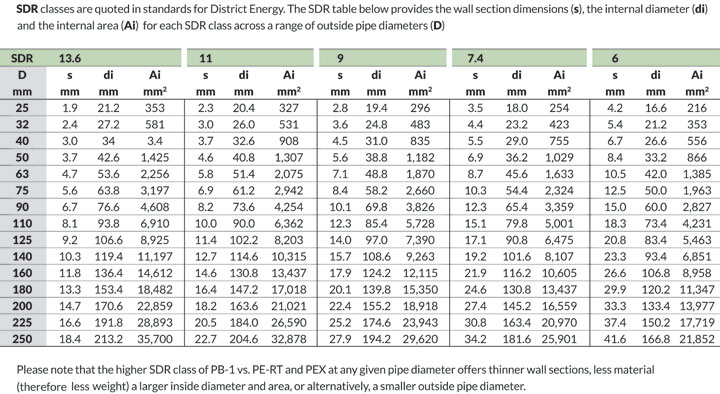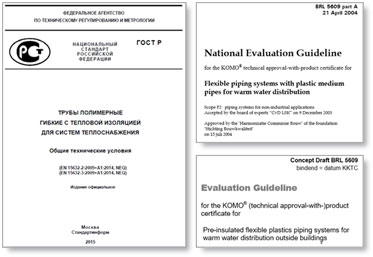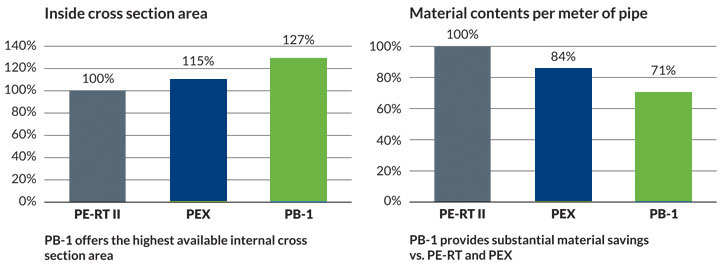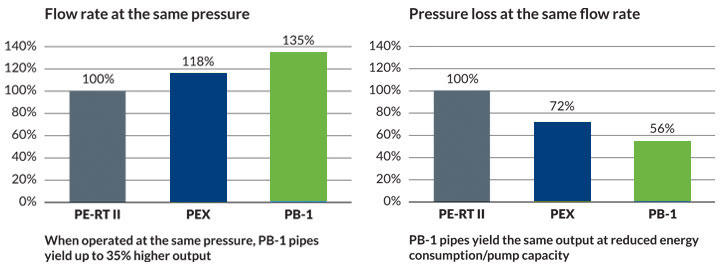What is District Energy?
District Energy systems supply hot water or steam for heating, and chilled water for cooling public buildings and facilities, apartment blocks, office complexes and similar structures from a central plant source.
PB-1 piping systems are specified for District Energy networks because of their flexibility, thermal efficiency and life expectancy at high temperatures of up to 95°C.
The hot or chilled water is distributed in insulated piping systems which are installed underground. In many European cities, large district energy networks are in operation, transporting heating or cooling over many kilometres with minimum thermal loss to consumers.
The key advantage of centrally produced heat (via water or steam) is that environmentally friendly sources can be used and combined. The major part is sourced from caloric power plants using the waste heat from electric power production. This is called co-generation. Electricity and heat produced at the same time doubles the efficiency rating compared to single electrical plants from 40% to over 80%. Other important sources are the heat from waste incineration plants, industrial processes and increasingly from green energy sources such as biomass, biogas, geothermal and solar.
Another kind of District Energy is the central supply of heating for schools and universities, hotel resorts, airports or shopping centres. This is called Group Heating.
Background

District Energy (also known as District Heating & Cooling) has been used for community heating for almost 100 years in Europe. Until 1980, only steel systems with insulation were installed, mainly in concrete ducts. Pre-insulated systems were introduced in 1974, but they still used steel pipes that had one main problem – corrosion. There was an incentive therefore for energy suppliers all over the world to search for non-corrosive solutions.
Pre-insulated piping systems
Pre-insulated PB-1 piping systems are a key component of District Energy. Using advanced production technology, pre-insulated pipes are made from environmentally friendly materials and fully recyclable grades from the Polyolefin material family. These materials include Polybutene-1 internal pipe, flexible, closed cell polyolefin foam and the flexible high density polyethylene outer cover.

The premium systems choice for District Energy
- Large diameters for both underground and internal installation
- High vapour resistance
- Heat loss of less than 1°C per km.
- High flexibility with small/medium diameters shipped and laid using coils
- Long lengths reduce connections
- Combines with weldable fitting systems
- Low weight for efficient logistics and handling
- No corrosion or problems with scale buildup
- Excellent chemical resistance particularly for aggressive geothermal water
- Long-term performance up to a maximum service temperature of 95°C, with the highest pressure rating compared to PE-X and PP.
- Comprehensive systems of pre-insulated pipes and weldable fittings available for the full spectrum of requirements.

PB-1 has the highest pressure rating compared to PE-X and PP, low heat loss, and best in class chemical resistance, particularly for aggressive geothermal water.
Polybutene-1 offers tangible benefits for District Energy systems compared to PE-RT and PEX
For District Energy projects, the true cost variation of piping systems across competing materials is more than a per length cost comparison for the same outside pipe diameter.
A true cost comparison between piping systems should include installation time, jointing options, life span and SDR rating.
Specifiers look at: ease of installation impacting onsite costs; jointing options, long-term system performance and projected life span; and Standard Dimension Ratio (SDR) comparing pipe materials for durability against pressure.
When compared to PE-RT and PEX systems, PB-1 offers significant benefits across a broad range of performance categories all contributing to make PB-1 piping systems the optimum choice for high performance District Energy installations.
Standard Dimension Ratio (SDR)
What is SDR?
The SDR or the Standard Dimension Ratio refers to the geometry of a pipe. SDR is a method of rating a pipe's durability against pressure and it describes the correlation between the pipe dimension and the thickness of the pipe wall. SDR 11, for example means that the outside diameter of the pipe is eleven times the thickness of the wall.
SDR rates pipe durability against pressure and correlates a pipe's outside diameter and wall thickness.
- High SDR ratio
The pipe wall is thin compared to the pipe diameter - Low SDR ratio
The pipe wall is thick compared to the pipe diameter

Example calculation:SDR for a pipe with an outside diameter of 100mm and wall thickness of 5mm can be calculated as:100mm / 5mm = SDR 20
Why does SDR matter for District Energy systems?
Due to the higher SDR ratio of PB-1 compared to either PE-RT or PEX, PB-1 piping systems deliver the following benefits because of its lower wall section requirements for the same pressure rating and outside pipe diameter:
- Less material for the same pressure capability
- Less weight per meter of pipe
- Lower outside pipe diameter for the same performance
- Larger inside area for the same outside diameter providing:
- Higher flow rate at the same pressure
- Lower pressure loss, requiring less energy to run a system or pumps with lower capacity

SDR Classes and Pipe Dimensions
SDR classes quoted in National Standards for District Energy piping systems

National Standards (RU & NL)
The source for District Heating piping dimensions comparing materials PB-1, PE-RT and PEX

The current Russian standard for District Heating (GOST 56730 – 2015) and the Dutch guideline (BRL 5609 - and the draft of renewed BRL 5609) both include a comparison of 3 materials for District Heating piping systems: PB-1, PE-RT & PEX
Both the Russian standard and the Dutch guideline have the same requirements in relation to the pipe dimensions and SDR classes of the 3 service pipe materials operating at pressures of 6 bar, 8 bar and 10 bar.

Per the Russian standard and the Dutch guideline the table (at right) is an excerpt of the relevant table showing the SDR classes for the listed materials at different pressure ratings. As indicated, for each operating pressure PB-1 is listed in the highest SDR class when compared to either PE-RT or PEX. The section below explains what this means, why standards refer to pipe dimensions and SDR classes and what are the benefits for pipe system specifiers.
Pipe Dimensions and SDR Classes
PB-1 pressure capability delivers benefits versus PE-RT and PEX
To illustrate the performance of PB-1, PE-RT and PEX in relation to the given operating pressure of 8 bar at the small pipe diameter of 50mm ø, the table and diagram below provide a comparison of the internal pipe dimensions required.
The higher SDR class of PB-1 delivers the following benefits:
• Thinner wall section
• Less material (less weight)
• Larger inside diameter and area
Example 1: Small pipe – 50mm diameter @ 8 bar
PB-1 is stronger than both PE-RT and PEX and with an operating pressure of 8 bar and an outside pipe diameter of 50mm ø the required wall thicknesses are:

Per above, at the same water pressure, the larger inside diameter of PB-1 50mm outside ø pipe delivers a substantially higher flow rate than the other two materials. Taken the other way, at a given flow rate PB-1 pipes yield a lower pressure loss requiring less energy to run systems and/or pumps with a lower capacity.

As shown in the graphs above and for the purposes of comparison, PE-RT may be considered the benchmark at 100%. When comparing the inside cross-section area of a 50mm ø pipe (left graph) PB-1 clearly outperforms PE-RT with an additional 27% of volume. Also, in comparing the amount of material per meter for a 50mm ø pipe rated for 8 bar (right graph), PB-1 pipe uses 29% less material than PE-RT.

Once again for the purposes of comparison, PE-RT may be considered the benchmark at 100%. Per the above graph (left), using the same operating water pressure, a 50mm outside diameter pipe (8 bar) made from PB-1 delivers a substantially higher flow rate of +35% when compared to the identically rated PE-RT pipe of the same outside diameter.
Measured using the other comparison point (right): at a given flow rate (output) PB-1 pipes yield a 44% lower pressure loss versus PE-RT pipes. This means that PB-1 pipes require less energy to run a system - or - can accommodate pumps with a lower capacity for the same output.
Example 2: Large pipe – 160mm diameter @ 10 bar

Due to a higher SDR rating (and therefore a thinner wall section) a PB-1 pipe of 140mm ø delivers the same performance as a PE-RT pipe of 160mm ø, but with a smaller outside diameter and larger inside pipe cross-section area.

At a 10 Bar operating pressure pipe of 160mm outside diameter:
- PE-RT @ SDR 6
160mm ø pipe has an internal cross section area of 8,958mm2 - PEX @ SDR 7.4
160mm ø pipe has an internal cross section area of 10,605mm2 - PB-1 @ SDR 9
With a smaller outside diameter of 140mm ø PB-1 has an internal cross section area of 9,263mm2
In addition, as shown in the graph (right), the weight of 160mm outside diameter PB-1 pipe rated for 10 bar is almost half of the weight for the same outside diameter and rating pipe made from PE-RT.
Jointing Techniques for District Heating Pipes
PB-1 is a versatile material for all available jointing techniques

The Bottom Line
Specifying PB-1 piping systems for District Energy offers:
- Substantial material saving opportunities, while at the same time increasing the capacity of the system
– thinner walls
– increase of the available inside cross section area - A higher degree of design freedom for District Energy grids
– opportunity for using smaller outside pipe and fitting diameters - A clear opportunity for reduced integral installation cost and operating cost
– smaller pipe support frames
– use of less insulation material
– smaller pumps running at reduced energy consumption
– lighter overall weight for easier handling and lower shipping costs - The capability to utilize all available jointing techniques
- Best in class acoustics including the lowest level of water hammer
- The ability to be fully recycled
PB-1 vs. PE-RT & PEX
Subject Webinar
Benefits of PB-1 for pressure piping systems
Business Review Webinars
- Sponsored by: LyondellBasell
- Presentation date: 7 March, 2019
- Presented by:
– Patrick van Beek, Marketing Manager PB-1
– Werner Rothhöft, Application Development & Technical Service Engineer - Key Learning Objectives | What does a higher SDR class mean in practice?
– Get to know Polybutene-1 for use in pressurized hot and cold water pipe systems
– Learn about the extraordinary characteristics of this most technically advanced thermoplastic material
– What are the benefits of using PB-1 in pipe systems against alternative thermoplastic materials?
– Opportunities to reduce the operational costs over the lifetime of a pipe system
Webinar: PB-1 for pressure piping sytems
What does a higher SDR class mean in practice?
University testing for the optimum inner pipe
An energy company based in Austria was one of the pioneers who investigated alternative solutions and instructed the Plastics Institute of the University of Leoben to carry out a testing program to find the best solutions for District Energy networks.
University result: "After 8 years in service, PB-1 pipe samples were stronger than new PB-1 pipes due to the tempering and annealing process over that period."
University results
The results for the inner pipe were clear: Polybutene-1 was the best plastic material for high temperatures (max. 95°C).
This result encouraged the Austrian energy company to undertake a joint venture with a pipe manufacturing company to produce and market pre-insulated piping systems with Polybutene-1 inner pipes.
Austrian District Energy network
Following those studies, 42 networks utilising 210 km of pipe have so far been installed in Austria. 70 km of pipe were installed prior to 1987. These networks were so called "secondary networks" which were supplied from primary lines by means of central transformer stations with heat exchangers to reduce temperatures to max. 90°C and pressure to 5 bar.
After 8 years in operation random samples of these Polybutene-1 pipes were sent to Austrian test institutes to compare the operational pipes with new ones. The amazing result was that the used pipes turned out to be even stronger than the new Polybutene-1 pipes – the tempering and annealing process on the pipes during service over the first eight years having a positive effect on the pipes.
Geothermal Centre – Vienna
The very aggressive geothermal water in Vienna caused big problems with corrosion in metal pipes. As a result, in 1972 when the new Geothermal Centre in Vienna was being planned, a 2 year test cycle was undertaken with various pipes made of stainless steel, PVC-C, epoxy and Polybutene-1.
Polybutene-1 proved to be the best material and was subsequently installed for all geothermal lines from the source to the geothermal centre, with a 225 mm OD twin main line of 1.4 km, and some 2 km of internal pipes in sizes 20 mm to 225 mm OD. These pipes operated continuously for over 30 years (until the facility was expanded) at 54°C and 10 bar with no breakdown.



